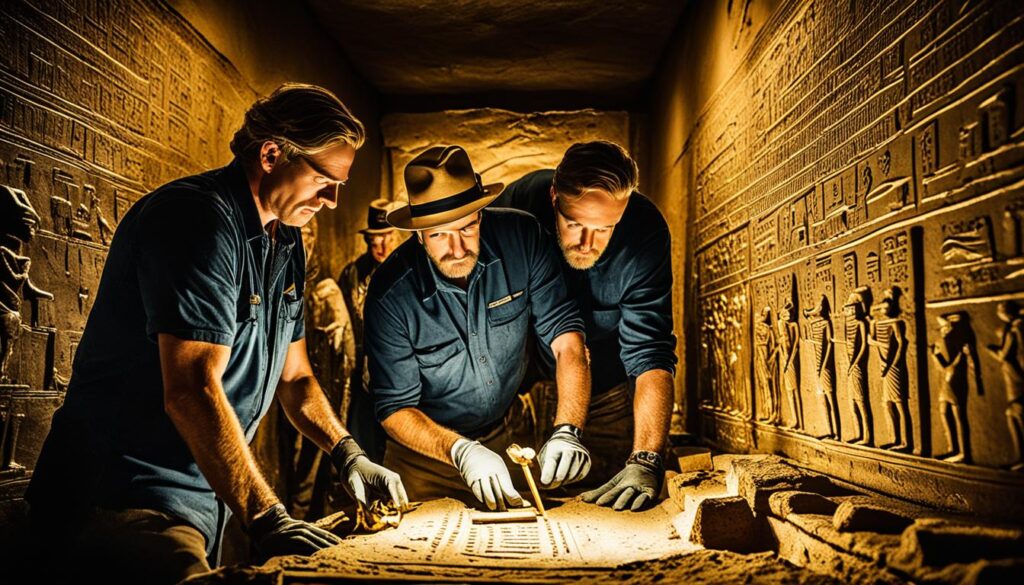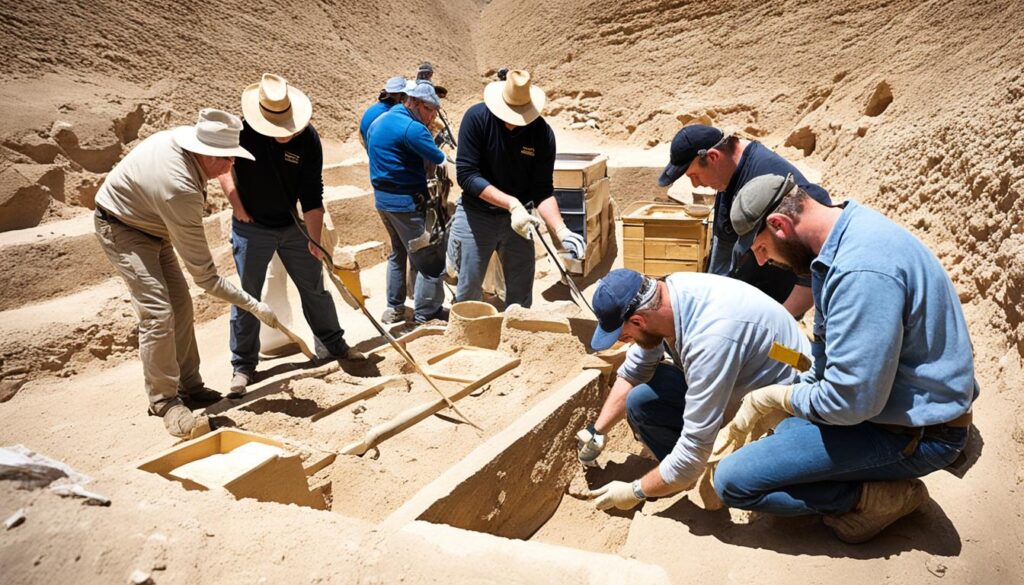The “Curse of King Tutankhamun’s Tomb” is a tale that has gripped the hearts of many. When Howard Carter found the young pharaoh’s tomb in 1922, it sparked a wave of interest. This discovery has kept the story of Tutankhamun alive, fascinating people for generations.
This article will explore King Tutankhamun’s history and the impact of his tomb’s discovery. We’ll look into the myths and facts of the “curse” that has intrigued people for nearly a century. Join us as we uncover the truth behind this captivating archaeological find that still fascinates the world today.
The Discovery of Tutankhamun’s Tomb
In 1922, the world was amazed by the discovery of Tutankhamun’s tomb. British archaeologist Howard Carter led this groundbreaking find. He had spent years searching for the young king’s tomb.
Howard Carter’s Groundbreaking Find
After years of hard work, Carter and his team found Tutankhamun’s tomb in the Valley of the Kings. This was a huge moment, as the tomb was mostly untouched by robbers for centuries. So, all the treasures and artifacts were still there, showing us what life was like back then.
Exploring the Treasures of the Ancient Tomb
When they opened the tomb, they saw something incredible. The walls had beautiful paintings and hieroglyphics. Inside, they found gold and jewel-encrusted items, furniture, and the pharaoh’s mummy. This find was huge, showing the world the beauty and history of ancient Egypt.
The discovery of Tutankhamun’s tomb by Howard Carter and his team was a major event in the 20th century. It gave us a deep look into the life and legacy of the young pharaoh and ancient Egyptian culture.
The Legend of the Mummy’s Curse
The discovery of Tutankhamun’s tomb in the early 1900s sparked a global fascination. It also brought about the “Mummy’s Curse” legend. This ancient superstition has kept people intrigued for many years. Stories of mysterious deaths and bad luck linked to the tomb have spread widely.
The ancient Egyptians thought the dead had powerful forces. They protected their kings and queens carefully. They believed disturbing a pharaoh’s tomb could lead to bad luck. This belief led to the Mummy’s Curse legend.
Many who worked on Tutankhamun’s tomb, like Howard Carter, faced early deaths or bad luck. This added to the Mummy’s Curse stories.
The Mummy’s Curse stories have captured many hearts and minds. While some see them as just old tales, they show the lasting impact of ancient Egyptian beliefs. They also keep the mystery of Tutankhamun alive.
Historical Curiosities: Fact or Fiction?
The fascination with Tutankhamun’s Curse has led to many historical mysteries and myths. It’s interesting to separate facts from fiction. By looking at archaeological evidence and scientific research, we can learn the truth about this mysterious curse.
Unveiling the Mysteries Behind the Curse
When Tutankhamun’s tomb was found in 1922, it sparked superstition and speculation. Reports of strange deaths and illnesses among those who worked on the site made people believe in a powerful curse. But, a closer look shows a more complex story.
Researchers have looked closely at the archaeological evidence. They have debunked many myths about the curse. While some deaths were unexplained, most were due to natural causes or illnesses common back then. The idea of a supernatural force targeting the tomb’s discoverers is not supported by science.
Also, the supposed “curses” often had simple explanations. For example, the idea that opening the tomb released a deadly “curse of the pharaohs” is not true. Studies show the air inside the tomb was not much different from outside.
By looking at historical facts and archaeological data, we understand the Curse of Tutankhamun better. The mysteries and legends around this ancient Egyptian icon still fascinate us. But, by focusing on evidence, we can tell what’s real and what’s not.
Tutankhamun’s Life and Legacy
Tutankhamun, known as the “Boy King,” is a key figure in ancient Egyptian history. He was born into a royal family and became pharaoh at a young age. His story, especially when his tomb was found in 1922, amazed people all over the world.
This section explores Tutankhamun’s life and his lasting impact. It looks at how he went from being a child ruler to a respected figure in ancient Egypt.
The Boy King’s Rise to Power
Tutankhamun became pharaoh at around eight or nine years old. His time in power was important for Egypt’s politics and culture. He helped bring back traditional religious practices and art styles that had faded during the rule of Akhenaten.
Through his efforts, Tutankhamun made a big mark on ancient Egyptian society. He played a key role in the Eighteenth Dynasty as one of the last pharaohs.
Even though he was young, Tutankhamun faced many challenges. He had to fix the problems caused by Akhenaten and win back his people’s trust. With strong actions and the help of his advisors, he was able to overcome these issues.
This made him one of the most important pharaohs in ancient Egyptian history.
Ancient Egyptian Burial Rituals
The ancient Egyptians thought life went on after death. Their detailed burial customs showed this deep belief in the afterlife. At the heart of these customs was mummification. It turned the dead pharaohs into beings ready for the next life.
Honoring the Pharaohs in the Afterlife
The pharaohs’ burials were a complex ritual. They were designed to help the pharaohs smoothly move into the afterlife. The tombs were filled with treasures and artifacts for the ruler in the next world. These included jewelry, tools, and other items chosen to help the pharaoh on their journey.
Mummification was key to ancient Egyptian burials. The pharaohs’ bodies were prepared carefully. Their organs were removed and preserved, and their skin and muscles were treated with natron to stop decay. This kept the deceased’s body intact, letting their soul return in the afterlife.
The tombs also had statues, paintings, and symbols of the pharaoh’s divine status. These were meant to be the pharaoh’s spirit’s home, keeping them powerful in the afterlife.
Tutankhamun’s tomb shows the deep respect the ancient Egyptians had for their rulers after death. These rituals and artifacts prove the pharaoh’s divine status and the belief in life after death.
The Aftermath of the Tomb’s Discovery
In 1922, British archaeologist Howard Carter found Tutankhamun’s tomb. This event shocked the world of scholars and caught everyone’s attention. It changed archaeology and still affects us today.
After the discovery, everyone was busy. Archaeologists were amazed by the many artifacts and insights into ancient Egyptian life. They worked hard to study and save these treasures. The public was also drawn in by the tomb’s mystery and grandeur, sparking a new interest in the pharaohs.

The discovery of Tutankhamun’s tomb changed our view of ancient Egypt. It gave us a lot of artifacts and information. This helped us understand their culture, beliefs, and way of life.
This find also made ancient Egypt popular again. Museums wanted the tomb’s treasures, showing them to the public. This sparked a big interest in Egyptology. Today, Tutankhamun is still linked with the mystery of the ancient world.
Ongoing Archaeological Explorations
The world is still captivated by Tutankhamun’s tomb and ancient Egyptian culture. Even after the initial discovery, archaeologists and historians keep searching for more secrets. They use new methods and technology to find out what the past holds.
Uncovering More Secrets of the Past
In recent years, there’s been a renewed interest in Tutankhamun’s tomb. Archaeologists use advanced tech and careful research to dig deeper. They’ve found new chambers and artifacts, giving us a better look at Tutankhamun’s life and death.
One big find was a hidden chamber near Tutankhamun’s tomb. It’s got everyone excited because it might hold more treasures or royal family members’ remains. Researchers are still studying this chamber, hoping to learn more about the Boy King.
Archaeologists aren’t just looking at Tutankhamun’s tomb. They’re exploring all of ancient Egypt to learn more about the civilization. They’re finding new tombs, temples, and studying old texts and artifacts. This work keeps bringing us new discoveries that change what we know about ancient Egypt.
The ongoing digs in Egypt keep us all on the edge of our seats. With every new find, we learn more about Tutankhamun and ancient Egypt. These discoveries are expanding our knowledge and making us more curious about this fascinating time in history.
The Enduring Fascination with Tutankhamun
In 1922, Howard Carter found Tutankhamun’s tomb, and it amazed the world. Even today, the young pharaoh’s story still captures our hearts. The discovery of his tomb has changed how we see ancient Egypt.
Capturing the Public’s Imagination
Tutankhamun’s tomb is known for its wealth and mystery. It has grabbed the public’s interest like no other find. The golden death mask and the detailed jewelry and furniture have made people curious about his life.
Now, Tutankhamun is a famous name. His story has led to many books, documentaries, and shows. These draw people from all over the world.
People love to learn about the ancient world and its secrets. The tomb’s discovery let us peek into the lives of ancient Egyptians. It showed us their daily life and rituals, with its beautiful treasures.
The discovery of Tutankhamun’s tomb has had a huge impact on culture. It has changed how we see ancient Egyptian society, art, and beliefs. It has also made people more interested in studying ancient Egypt, leading to more research and exploration.
The Curse: Separating Myth from Reality
The Curse of Tutankhamun has always caught our attention, with stories of mysterious deaths and supernatural forces. But, looking closer at the historical facts and evidence, we see the truth is more complex. It’s not just the sensational stories that have been passed down.
Tutankhamun’s curse has sparked debate and speculation. Some believe a series of deaths after the tomb’s discovery were due to a curse. But, a closer look shows most deaths were from natural causes or illnesses. The timing of these deaths was likely just a coincidence, not a curse.

The archaeological evidence helps debunk the myths about Tutankhamun’s curse. The tomb’s contents and how they were found show no signs of ancient curses or traps. Instead, they reveal a burial process that was common in ancient Egypt.
By looking at the facts and data, we can understand the Curse of Tutankhamun better. While the mysteries of the pharaoh’s tomb still fascinate us, it’s important to be critical. We should question the myths that have grown around this historical figure.
Preserving Historical Treasures for Future Generations
Tutankhamun’s tomb holds treasures that are crucial for understanding ancient Egypt’s history and culture. These artifacts are priceless and tell us about the past. It’s vital to keep them safe for those who come after us.
Museums worldwide are working hard to protect Tutankhamun’s artifacts. They use advanced climate control and careful conservation. Their goal is to show the public the beauty and mystery of the boy king’s tomb. They also offer educational programs to deepen our understanding of ancient Egypt.
Archaeologists are still finding new artifacts and secrets about Tutankhamun. These discoveries help us learn more about his life and times. Their work is key to keeping Egypt’s cultural heritage alive. By preserving the past, we ensure that future generations can also marvel at Tutankhamun’s legacy.






